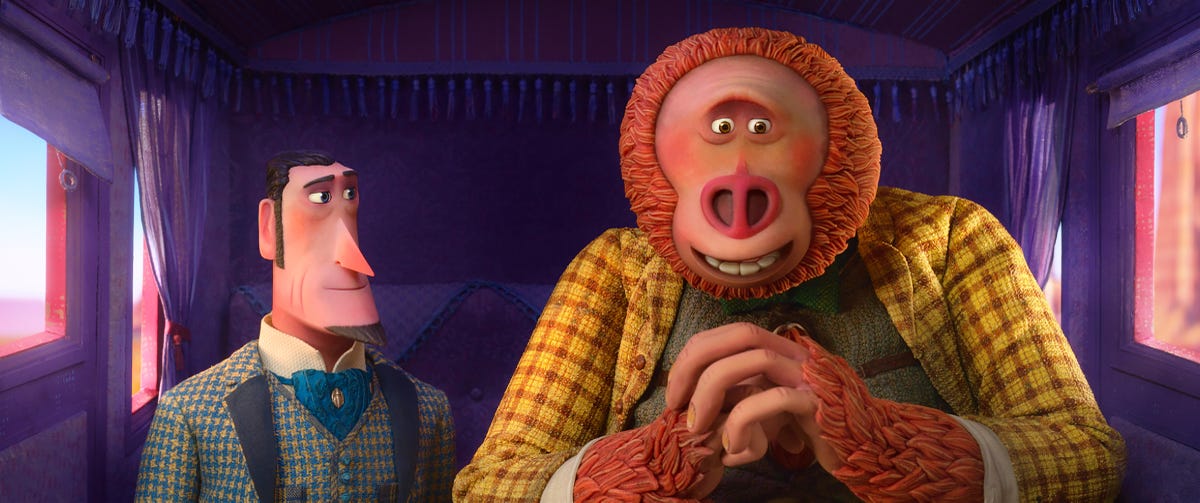Missing Link: Step inside Laika's epic Bigfoot adventure
The stop-motion animation studio's latest movie is a colorful travelogue featuring a big-hearted beast. Take a look behind the scenes.

Missing Link
Missing Link, the latest movie from stop-motion animation studio Laika, follows a lonely Sasquatch, Mr. Link (voiced by Zach Galifianakis), as he treks across the globe with adventurer Sir Lionel Frost (Hugh Jackman) in search of long-lost relatives. Let's take a look behind the scenes at Laika Studios, just outside Portland, Oregon.
Mr. Link
Even a Sasquatch needs clothes for a trip around the world. Laika made about 10 of these clothed Link puppets, along with 10 or 11 naked versions.
Sir Lionel Frost
Sir Lionel Frost (voiced by Hugh Jackman) vows to help Link find the valley of Shangri-La and his long-lost family. As with Link, Laika produced around two dozen Lionel puppets so multiple animators could film at the same time on different sets.
Adelina Fortnight
Link also gets help from Adelina Fortnight (voiced by Zoe Saldana), shown here in various fashion-forward Victorian-era looks. The puppet at the far right is Adelina before she's got her face on.
3D-printed faces
Laika 3D-printed over 106,000 faces in color for Missing Link. That's a huge leap from its first movie, Coraline, when it printed around 20,000 faces that then had to be hand-painted. Animators replace puppets' faces sometimes up to 24 times for one second of film.
Eyes without a face
The technique, called replacement animation, involves taking a picture of the puppet wearing one face and then swapping in another with a slightly different expression. For this film, director Chris Butler and the animators mapped out ahead of time exactly what those expressions would be.
A sharp stick in the eye
Brian McLean, director of rapid prototype at Laika, demonstrates how animators stab a puppet's eyeballs with an X-Acto blade to move them around and get them just right for a shot.
Naked Link
Link is all furry on the outside but inside he looks more like an android. His armature, with over 250 components, gives the puppet a human-like range of movement.
Costume designer Deborah Cook
Costumer designer Deborah Cook shows off one of the movie's puppets. Meticulous research goes into every character's costumes. Flat, shiny fabrics don't photograph well so texture is key.
Sir Lionel Frost's look
How do you dress a Victorian-era explorer who's only around 10 inches tall? With handmade clothes of course. Here's one of Sir Lionel Frost's outfits and a closer look at some of the patterns Laika created.
A doll's house
Missing Link, around an hour and a half long, has about 60 different locations, says production designer Nelson Lowry. Every single thing gets designed, from the architecture and the furniture to the trees and their leaves in the forest.
Into the woods
This forest set from Missing Link is elevated and the tables underneath can be moved apart to give animators easy access to exactly where they want to be.
Canon 5D Mark III
Laika uses Canon's 5D Mark III to capture stills for its stop-motion movies.
Link's cave
At left is the artwork that inspired the look of Link's cave. You can see how closely the set matches.
Sir Lionel Frost's office
Because Lionel is lanky, everything in his office is really exaggerated and the proportions stretched, from the door to the chaise lounge, says Lowry.
Santa Ana train station
One of the movie's settings is the Santa Ana train station. This train is a character too, says Lowry. It can be fully animated and it has a giant steel chassis built by the engineering department. "It moves very beautifully, all driven by hand of course," he says.
Train car
A separately built train car has a whole side that slides out so animators can get access and position the puppets just right.
Rigging
In stop motion, puppets can't leave the ground without an assist. Props and set pieces can also need help. That's where rigging comes in. Ollie Jones, head of rigging, demonstrates how they filmed a shot of Link's butt.
Never breaking scale
Laika doesn't break scale, so it'll often build overscale pieces. "This is the first time, and maybe the last time they'll ever produce a 300% butt piece for a movie," says Jones. Here, it's surrounded by the rigging needed to help animate the scene. The tennis balls are there so no one loses an eye.
The stagecoach
A scene featuring a stagecoach rumbling through the desert required what was probably the most rigs ever packed into a square-foot set, says Jones. Even the shades, curtains and tassels were rigged. The visual effects team then goes in later to wipe out all the rigging equipment.
The ice bridge
This is the full-size, puppet version of the towering ice bridge in the Himalayas, where part of the third act takes place. The Yeti temple in the background features a smaller version of the ice bridge.
The Yeti temple
It was fun to depart from real-life settings to design the Yeti temple, says Lowry, the production designer.
The jet pack
The Elder Yeti (voiced by Emma Thompson) is shown in a seated position (left) and with a "jet pack," which enables an animator to move a puppet around without touching its torso. Laika invented the jet pack for Kubo and the Two Strings. "Stylistically, it's a very naturalistic, very nuanced way of animating," says Jones.

